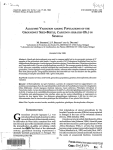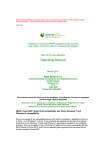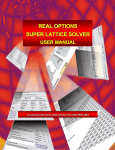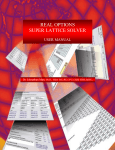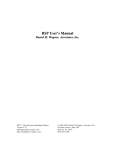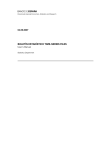Download Operating Instructions for Option0402class.xls Purpose: The
Transcript
Operating Instructions for Option0402class.xls Purpose: The purpose for option0402.xls is to simulate profit profiles for option trading strategies using both historical simulation and Monte Carlo methods. Users may specify transactions costs, bid-ask spreads, margin balances, the details on up to four different options, gain/loss limits, holding period limits, as well as individual asset parameters. You may also give details for a non-option portfolio correlated with the underlying asset on the option. The maximum period of time that option0402class.xls allows a trading strategy to remain open is 100 trading days. For the program to work correctly, the calculation method must be set to manual. Always make sure when you use the program that the calculation method has been set correctly. Worksheets: I. Control Worksheet The Control worksheet is used to input the control parameters to run the simulations. Areas where the user can input data are in green. The blue areas are calculated in the spreadsheet. The Control worksheet is the only worksheet requiring user input after initial setup.1 The input variables on the Control worksheet include: 1. Number of Simulations: This gives the number of times the simulation will be run. For versions of Excel prior to Excel 2000, the maximum number of simulations is 8,000. With Excel 2000 the maximum number of simulations is 50,000. 2. Simulation Method: The user will either type “M” or “H” in the box. If the user types “M” returns are estimated through Monte Carlo methods – estimating future returns through random simulations based upon parameter values previously estimated through a Maximum LikelihoodGARCH approach. Monte Carlo simulations generate 1 The Historical Data Worksheet is the only other worksheet requiring user modification. 1 returns by randomly selecting an error from the Historical data worksheet and then adding it to: µ + γ σ t −1 If the user types “H” returns are generated by randomly selecting actual returns on the underlying asset.2 3. Investment in Underlying Asset: This gives the total dollar investment in the exact asset underlying the option. 4. Investment in Non-option Portfolio: This gives the total dollar investment in any asset not including the option or the asset underlying the option. 5. Annualised Expected Return on Non-option Portfolio: This gives the annual expected return for the investor’s portfolio (not including the option holdings). This portfolio may not be the same as the underlying asset for the option. 6. Annualised Standard Deviation on Non-option Portfolio: This gives the annual standard deviation for the investor’s portfolio (not including the option holdings). This portfolio may not be the same as the underlying asset for the option. 7. Correlation of Non-option Portfolio Relative to Underlying Asset: This gives the sensitivity of the investor’s portfolio (not including the option holdings) relative to the asset underlying the option. 8. Close-Out Loss Limit for Options ( % ): This gives the loss that must be realised by the option portfolio in order for the option position to be closed.3 For example, if the Close-Out Loss Limit is – 20 % the option portfolio will be closed at the point where the accumulated return on the option portfolio is below – 20 %. 2 Actual returns will be copied into Column B and errors will be copied into Column C of the Historical Data worksheet. 3 It should be emphasised that the close-out limits look at the return on the option portfolio only – not the entire portfolio of the investor. 2 Note that the total portfolio may stay open longer than the option portfolio. The Evaluation Period for the Total Portfolio gives the total period of evaluation which may exceed the period of time the option position stays open. 9. Close-Out Gain Limit for Options ( % ): This is similar to the Close-Out Loss Limit. If the accumulated return on the option portfolio exceeds the Close-Out Gain Limit, the option portfolio position is closed.4 10. Minimum Days to Keep Option Position Open: As the name implies, this parameter will specify the minimum days we must hold open our option portfolio. This variable will take precedence over the Gain/Loss Limits. That is, regardless of how much our portfolio loses or gains, it will be kept open until the Minimum Days requirement has been met. The minimum value for this parameter is 0. 11. Maximum Days to Keep Option Position Open: This gives the maximum days the option portfolio position will be kept open. After this time the option portfolio will be closed. The maximum value for this parameter is 100 trading days. 12. Evaluation Period for Total Portfolio: This gives the total period of evaluation for the non-option and option portfolios. The option position may be closed out prior to the end of the evaluation period. The returns over the remaining period would then be determined entirely by the performance of the non-option portfolio. 4 What does it mean to “close” an option portfolio position? To close an option portfolio position we would simply enter into offsetting trades. For example, if we had initially bought a call option, to close our position we would simply sell it on the market. We keep track of our daily portfolio return by comparing the value of the option with our initial purchase price. If we had initially sold a call option, we would close our position by buying the same option on the open market. We can track our daily returns for an open short position by comparing the cost to buy the option with the proceeds we initially received (the premium) from selling it at Day 0. This will give the net gain to the short position. The denominator reference to compute return depends upon the amount we invest with the broker as margin to cover the short. 3 Note that if the total portfolio consists entirely of an options position, the evaluation period is meaningless and the total period for analysis will consist of the time during which the option position remains open. In effect, the Maximum Days and the Minimum Days described above will determine the evaluation period when the investment in the non-option portfolio is set to zero. Note that the Evaluation Period for the Total Portfolio will take precedence over the settings for Minimum Days to Keep Options Position Open and Maximum Days to Keep Options Position Open. 13. Margin Requirement (Long): The margin requirement (long) specifies the proportion of the option cost that the buyer must pay at Day 0. For example, if the long margin requirement is 60 %, the the option buyer must pay 60 % of the option cost at Day 0. The option buyer will borrow the remaining 40 % from the broker and pay interest on this loan. 14. Margin Requirement (Short): The broker may require the investor to place additional capital to cover a short position. This variable is the amount (as a percent relative to the initial premium received) that the investor will be required to place with the broker as security to cover any future liability. For example, if a call option is sold for $10,000 and the short margin requirement is 150 %, the option seller would be required to give another $15,000 to the broker. The spreadsheet does not consider the premium received from selling the option to cover the short margin requirement. 15. Use Short Proceeds to Purchase Long?: The user will either type “Y” or “N” in this box. When options are sold, the seller receives the option premium. If the option seller can then use this premium to purchase other options, this parameter would be set to ‘”Y”. Otherwise, it will be set to “N”.5 5 In general, the premium received from selling an option is held by the broker to cover any future liability with the short position. 4 16. Transactions Costs (one side per option contract): This is the transactions cost required to be paid for each trade on an option contract. For example, if the transactions cost per contract is 2 percent, the total transactions cost to buy and then later sell the option would be 4 percent. 17. Interest Paid/Given on Margin Balance: This is the interest earned/paid on the balance placed/borrowed with the broker. The option premium on a short position is assumed to earn interest. 18. Base Vol Markup for Option (in Annual Standard Deviation): Typically, the implied volatility on an option will be greater than the starting standard deviation. After the Beginning Daily Standard Dev is set you take the difference: Avg (VIX / VXN) volatility − starting vol * 250 19. Option Vol Control: Typically, the volatility of the volatility is much higher with GARCH models than the typical volatility of implied volatilities in options markets. This parameter is used to diminish the volatility of the base volatility used to determine implied volatilities for options. Larger values of this parameter will diminish the daily percentage changes in the base option volatility. 20. Call – Put Volatility (in Annual Standard Deviation): This gives the difference in annual implied volatility for call and put options. Implied volatility is determined by market prices which is itself determined by supply/ demand factors. If the Call – Put Volatility value is 0.02, the implied volatility of call options will be 0.02 greater than the implied volatility for put options. 21. Bid/Ask Spread (in Annual Standard Deviation): Option ask prices will be greater than option bid prices. Accordingly, because implied volatility is determined by option price, ask implied volatility will be greater than bid implied volatility. 5 22. Time Effect on Standard Deviation (Call and Put): We will often see that the implied volatility for short-maturity options is above the implied volatility for long-maturity options. Because of this, we often see a negative relation between option implied volatility and maturity date of the option. 23. Volatility Up Smile Call: This parameter sets the relation between implied volatility and a function of the exercise price of the call option where the call option’s exercise price is above the current asset price. The exact function of the exercise price is given by:6 G = T X S rf div é X ln ê ( r − div )T T êë S e f 1 ù ú , úû is the remaining maturity of the option in years , is the exercise price of the option, is the asset price, is the risk-free rate, is the dividend yield on the asset 24. Volatility Down Smile Call: This parameter sets the relation between implied volatility and a function of the exercise price of the call option where the call option’s exercise price is below the current asset price. The exact function is detailed in number 22 (Volatility Up Smile Call). 25. Volatility Up Smile Put: This parameter sets the relation between implied volatility and a function of the exercise price of the put option where the put option’s exercise price is above the current asset price. The exact function is detailed in number 22 (Volatility Up Smile Call). 26. Volatility Down Smile Put: This parameter sets the relation between implied volatility and a function of the exercise price of the put option where the put option’s exercise price is above the 6 See John Hull’s discussion of the volatility smile. 6 current asset price. The exact function is detailed in number 22 (Volatility Up Smile Call). Note that the general expression used to determine an option’s implied volatility on any given day is given by: Option Base Vol ± (Call – Put Volatility) ± Bid/Ask Spread + Time Effect on Implied Volatility * (remaining maturity of option in years) + Volatility Up/Down Smile (Call or Put) * G 27. Asset Parameters: These parameters are estimated using the stock.xls file. These parameters are used to simulate returns for the Monte Carlo simulations and to simulate daily volatilities for the Monte Carlo and Historical simulations. The Beginning Daily Standard Dev should be set such that the underlying asset standard deviation trends neither up nor down during the simulations. This parameter will have different values for the Monte Carlo and Historical simulation methods. It is critically important that this parameter be set correctly. Note that when you set the Beginning Daily Standard Dev you will need to reset gamma when you run Monte Carlo simulations. See the discussion on page 20 concerning how to do this. 28. Option Parameters: These are the parameters to be specified by the user for the specific option contracts to be held during the simulation. The Option Multiplier parameter specifies the number of options to be held with each option contract (e.g. for options on the S&P 500 the multiplier is 100, for options on the All-Ords the multiplier is 25.) 29. Expected Probabilities This section allows the user to impose a probability belief onto the simulation. The inputs to this portion of the Control worksheet will only affect historical simulation, but its results can also be used to modify the parameters for Monte-Carlo methods. 7 The user will first specify the number of days over which the probability belief will be imposed. The user will then set return bounds and probabilities that the actual return will be less than the return bound during the time interval for consideration. The sum of these personal probabilities must be equal to one. Once the user has set the bounds for the probability beliefs, the Expectation macro should be run by pressing the Compute Probabilities button. The actual probabilities for returns within the bounds set will be computed from the actual historical returns. The Expectation macro will also reset the probability of getting each historical return according to your expectations. This will be discussed in greater detail later in this document. For the Expectation macro to work correctly, it is important that the user choose bounds for returns that assign a nonzero actual probability to the return range. The user has the choice of either running one simulation at a time or running up to 50,000 with resulting summary statistics computed.7 To run one individual simulation, the user need only to recalculate the spreadsheet by pressing F9. Summary output metrics for the one simulation are given at the bottom of the Control worksheet. If the user wishes to run several simulations at once with summary statistics on the output metrics given, then the user will need to run the Master macro by pressing the Run Simulations button at the top of the Control worksheet. The output metrics provided by the simulation program include: 1. Total Portfolio Investment: This gives the total initial investment including options costs, margins held to cover short options positions, and the value of the non-option portfolio. 2. Option Investment: This gives the investment in the options component of the portfolio. This includes premiums paid on the options as well as margins held to cover short options positions. 7 On versions of Excel prior to Excel 2000 only 8,000 simulations may be run. 8 3. Portfolio Delta Today: This portion of the program is not yet complete. 4. Portfolio Gamma Today: This portion of the program is not yet complete. 5. Portfolio Theta Today: This portion of the program is not yet complete. 6. Portfolio Vega Today: This portion of the program is not yet complete. 7. Terminal Portfolio Value: This gives the ending portfolio value at the number of days set by the user for the Evaluation Period for the Total Portfolio. 8. Portfolio Return During Period: This gives the return for the total portfolio over the evaluation period and includes transactions costs on the options. 9. Days to Realise Portfolio Return: This is the total number of days over which the portfolio return is realised and will be equal to the Evaluation Period for the Total Portfolio unless the investment in the non-option portfolio is zero and the Maximum Days to Keep Option Position Open is less than the Evaluation Period for the Total Portfolio. 10. Minimum Portfolio Return During Period: This metric gives the lowest total return realised during the Days to Realise Portfolio Return. That is, this shows the very worst total return during the time that the portfolio position is kept open. 11. Maximum Portfolio Return During Period: This metric gives the highest total return realised during the Days to Realise Portfolio Return. That is, this shows the very best total return during the time that the portfolio position is kept open. 9 12. Annualised Portfolio Return: This metric annualises the Portfolio Return During Period. 13. Terminal Option Value: This gives the final value inclusive of transactions costs to the option portfolio. 14. Option Return During Period: This gives the return to the options portfolio inclusive of transactions costs over the Days to Realise Option Return. 15. Days to Realise Option Return: This is the total number of days that the options portfolio is kept open. This metric will be determined by the Minimum Days to Keep Option Position Open, Maximum Days to Keep Option Position Open, Close-Out Loss Limit for Options, Close-Out Gain Limit for Options, and the Evaluation Period for Total Portfolio. 16. Return On Underlying Asset Over 100 Day Period: This gives the realised return over a 100 day period for the asset underlying the option. We can use this metric to determine whether the simulations are realistically modelling returns. 17. Annualised Return On Underlying Asset Based on 100 Day Period: This metric annualises the Return On Underlying Asset Over 100 Day Period. 18. Return On Underlying Asset At Option Close: This gives the return on the underlying asset at the option close date (given by Days to Realise Option Return). 19. Annualised Return On Underlying Asset Based On Option Close Return: This metric annualises the Return On Underlying Asset At Option Close. 10 20. Average Underlying Asset Volatility Over 100 Day Period: This gives the average of the daily standard deviations for the underlying asset. Ideally, we wish this value to be close to the Beginning Daily Standard Deviation if we do not expect volatility to trend up or down. 21. Volatility of Underlying Asset at Option Close Date This gives the standard deviation of the underlying asset at the date the option position is closed out. The Additional Diagnostics section on the Control worksheet can be used to determine to what extent the results are being determined by changes in volatility alone. In addition, diagnostics are provided for select measures conditional on the option portfolio experiencing a gain. These measures will help us determine exactly why the option portfolio is experiencing gains/losses. 1. Average Option Base Vol Ratio Over 100 Day Period We can use this measure to determine whether the base volatility for the option is trending up or down during the simulations. This measure gives the average daily base implied volatilities divided by the beginning base implied volatility. If we expect that the implied volatility for options will remain fairly constant, we would desire the value for this metric to be fairly close to one. 2. Option Base Vol Ratio to Begin at Option Close Date: This measure gives the ratio of the base option implied volatility at the option close date divided by the beginning base option implied volatility. A value greater than one indicates that the option portfolio is closed out when implied volatility is higher in the market. A value less than one indicates the opposite. 3. Average Abs Percent Change in Option Base Vol Over 100 Day Period: This measure gives the average absolute value of the daily percent change in the option base volatility during the 100 day period. Greater values of the Option Vol Damper will result in smaller values for the Average Abs Percent Change in Option Base Vol Over 100 Day Period. 11 4. Minimum Percent Change in Option Base Vol Over 100 Day Period: This measure gives the minimum value of the daily percent change in option base volatility during the 100 day period. Greater values of the Option Vol Damper will result in lower values in magnitude for the Minimum Percent Change in Option Base Vol Over 100 Day Period. 5. Maximum Percent Change in Option Base Vol Over 100 Day Period: This measure gives the maximum value of the daily percent change in option base volatility during the 100 day period. Greater values of the Option Vol Damper will result in lower values in magnitude for the Maximum Percent Change in Option Base Vol Over 100 Day Period. 6. Percent Change in Option Base Vol at Option Close Date: This measure gives the percent change in option base volatility at the option close date. This measure will provide some indication as to whether large changes in implied volatility are resulting in the close-out of the option position. 7. Option 1 Vol Ratio to Begin at Option Close Date: This measure gives the ratio of option one implied volatility at the option portfolio close date divided by the beginning option one implied volatility. A value greater than one indicates that option one is closed out when its implied volatility is above the beginning value of its implied volatility. A value less than one indicates that option one is closed out when its implied volatility is less than the beginning value of its implied volatility. Similar measures are given for options two through four. 8. If Gain: Days to Realise Option Return: This measure gives the number of days to realise the option return if the option portfolio experiences a gain. This measure will help to determine whether options portfolios with gains are closed out earlier or later than those that are experiencing losses. 12 This measure will be the same as Days to Realise Option Return when the option portfolio experiences a gain. 9. If Gain: Return on Underlying Asset at Option Close: This measure gives the return on the underlying asset at the option close date if the option portfolio experiences a gain. This measure will help determine the level of return necessary on the underlying asset in order for the option portfolio to experience a gain. This measure will be the same as Return on Underlying Asset at Option Close when the option portfolio experiences a gain. 10. If Gain: Volatility of Underlying Asset at Option Close This measure gives the volatility of the underlying asset at the option close date if the option portfolio experiences a gain. This measure will help to determine the link between option portfolio gains and the level of volatility in the underlying asset. This measure will be the same as Volatility of Underlying Asset at Option Close Date when the option portfolio experiences a gain. 11. If Gain: Option Base Vol Ratio to Begin at Option Close Date This measure gives the ratio of the base option volatility at the option portfolio close date to the beginning base option volatility if the option portfolio experiences a gain. This measure will provide an indication of the link between the option portfolio gains and the level of implied volatility. This measure will be the same as Option Base Vol Ratio to Begin at Option Close Date when the option portfolio experiences a gain. 12. If Gain: Percent Change in Option Base Vol at Option Close Date This measure gives the percent change in the option base volatility if the option portfolio experiences a gain. This measure will help to determine the link between option gains and one day jumps in implied volatility. This measure will be the same as Percent Change in Option Base Vol at Option Close Date when the option portfolio experiences a gain. 13 13. If Gain: Option 1 Vol Ratio to Begin at Option Close Date: This measure gives the ratio of option one implied volatility at the option portfolio close date divided by the beginning option one implied volatility if the option portfolio experiences a gain. A value greater than one indicates that option one is closed out when its implied volatility is above the beginning value of its implied volatility. A value less than one indicates that option one is closed out when its implied volatility is less than the beginning value of its implied volatility. Similar measures are given for options two through four. II. Simulation Worksheet The Simulation worksheet is used to actually conduct the simulations. For Monte Carlo Simulations, an error is randomly drawn and then added to the expected return model. For Historical Simulations, a return is randomly drawn from the historical return series for each day. Volatility is modelled as a GARCH process in both cases. The results of the Simulation worksheet are given on the Control worksheet as each individual simulation is run. To run one individual simulation the spreadsheet needs to be recalculated by pressing the F9 key. Every time F9 is pressed the RAND() function will generate a new set of random numbers. Once these random numbers are generated, stock returns will be determined which will then affect option values and the value of your portfolio. You can quickly do several manual simulations by simply pressing F9. Note that you will need to run the Master macro to produce summary statistics for your simulations. Note that the relation between the return on the non-option portfolio and the return on the underlying asset is determined as follows: ~ E[R] ~ R− R U − E[R U ] 250 = p* + stocksd dailysd dailysd * 250 begdailysd ~ 1− p2 * Z Þ ~ R U − E[R U ] stocksd dailysd ~ * R = p * * dailysd begdailysd 250 + stocksd dailysd E [R] ~ * 1− p2 * Z * + 250 begdailysd 250 14 where ~ R p is the simulated daily return on the non-option portfolio, is the Correlation of Non-Option Portfolio Relative to Underlying Asset, ~ RU is the simulated daily return on the underlying asset to the option, ~ E [ R U ] is the daily expected return on the underlying asset to the option, dailysd is the daily standard deviation on the underlying asset to the option, stocksd is the Annualised Standard Deviation on Non-option Portfolio, begdailysd is the Beginning Daily Standard Deviation on the underlying asset to the option, ~ Z is a random variable from a Normal distribution with mean of 0 and variance of 1 Note that the above relation between the simulated daily return on the non-option portfolio and the simulated daily return on the asset underlying the option is taken from the below fact: ~ ~ If we have two random variables, X 1 and X 2 , with a bivariate normal distribution with correlation given by p, then the ~ ~ relation between X 2 and X 1 can be expressed as: ~ ~ ~ X 2 = p * X1 + Z * 1− p2 ~ ~ when X 1 and X 2 have mean equal to zero and unit variance. The implied volatility of the options is determined as follows: Implied volatility = Base option volatility ± Call / Put Spread ± Bid/Ask Spread + G * volsmile + Remaining maturity on the option * tvol The volsmile parameter used will depend on whether the option is in the money and whether it is a call or a put option. The tvol parameter will also be estimated separately for call and put options. In general, the volatility parameters will be estimated as follows: 1. Run a regression for call and put options separately 15 2. Use the option implied volatilities as the dependent variables (expressed in daily values) 3. Estimate the following regression model: Implied vol = c + β 1 * time to maturity + β 2 * D1 * G + β 3 * D2 * G where D1 = 1 0 if G > 0 otherwise D2 = 1 0 if G < 0 otherwise G = é ù X ln ê ( r − div )T ú T ëê S e f úû 1 III. Histogram Worksheet As the name implies, the Histogram worksheet produces a histogram for the resulting output of the simulations. This graph will be updated each time the Master macro is run (by pressing the Run Simulations button.) IV. Results Output statistics for a simulation run are given on the Results worksheet. Output statistics for various measurement variables include: average, standard deviation, minimum, maximum, and percentile values. The measurement variables include all of the output metrics given on the Control worksheet. V. Historical Data Worksheet This worksheet is used as the data source for conducting simulations using actual historical returns (in Column B) and Monte Carlo simulations (in Column C). It is important to remember that Monte Carlo methods never use actual returns in the simulations. When the user wishes to test trading strategies for a particular option, the actual returns must be pasted in Column B of this worksheet (at theappropriate place). Of course, prior to this the previous data in Column B needs to be cleared. To run Monte Carlo simulations, the errors from the GARCH model must be copied from stock.xls into Column C. Remember that the error on any date t is calculated as: 16 Return on date t − E [ Return for date t ] Column A of the Historical Data worksheet gives the probability assigned to each possible return. These probabilities are calculated by running the Expectation macro (by pressing the Compute Probabilities button on the Control worksheet). VI. Payoff Diagram and Diagram Worksheet The Diagram worksheet allows the user a quick reference for the profit profile for any particular total portfolio construction specified in the Control worksheet. This worksheet can be used to determine the profit payoff of a particular portfolio as time passes and as the underlying asset price changes.8 Macros: The option0402class.xls file contains two macros to aid in the analysis. The macros may be started by going to Tools – Macro (selecting the macro) and then pressing Run. Each of the macros also have a button that can be pressed to initiate execution. I. Master [ CTRL + SHIFT + M ] The Master macro is used to actually conduct the simulations, copy and paste the results from the Control worksheet to the Results worksheet, and then to compute and print the histogram on the Histogram worksheet. To examine the Master macro you can go to Tools – Macro (select the macro) and then press Edit. The VBA window editor will then appear and you can make changes (at your own risk) to the macro. The macro was originally recorded using the RECORD NEW MACRO feature in Excel. The macro loops using a FOR – NEXT command which was later added directly to the VBA window. The Master macro may also be initiated by pressing the Run Simulations button on the Control worksheet. II. Expectation The Expectation macro is used to set up the probabilities to run a Historical simulation. Before running the Expectation macro, the user should first copy the actual returns on the underlying asset into Column B on the Historical Data worksheet. 8 One important variable which is held constant for the analysis on the Diagram worksheet is the volatility. Changes in volatility can have a major impact on portfolio performance. 17 Once the user has copied the returns into the Historical Data worksheet, the table on the Control worksheet below the Compute Probabilities button should be filled in. The user need only fill in the green cells in this table. The user should first input the number of days over which the expectation is held. The user will then input the return bounds and the associated personal probability that the return will be less than the return bound. The sum of these probabilities should be one. Once the user has input the return bounds and their associated probabilities, the Expectation macro should be run by pressing the Compute Probabilities button. The macro will then fill in Column A on the Historical Data worksheet as well as give the actual probabilities on the Control worksheet. If the any of the actual probabilities have a value of zero once the Expectation macro has been run, the return bounds will need to be reset to ensure that all of the actual probabilities have a nonzero value. Operation of the Spreadsheet: I. Set the spreadsheet to manual calculation [ VERY IMPORTANT ] When the spreadsheet is first opened on any computer make sure the calculation is set to manual. To do this go to Tools – Options – Calculation, then press Manual. Later, to recalculate the spreadsheet (manually) you will need to press the F9 key. The reason we need to use manual calculation is the actual simulation is conducted by using the RAND ( ) function which recalculates every time the ENTER key is pressed or one of many operations occur (such as copying and pasting). Every time the F9 key is pressed a new simulation will be run and the results can be viewed in the Control worksheet. If you wish to run many simulations at once, save the results, and produce summary statistics, then you will run the Master macro. The number of simulations which will be run is set in the Control worksheet. II. Copy and paste the returns for the underlying asset to Column B of the Historical Data Worksheet. Also, copy and paste the errors from the GARCH model into Column C. Run the Expectation macro. Historical simulation will randomly draw actual returns from Column B. Monte Carlo simulation will randomly draw errors from Column C. 18 III. Copy and paste the Asset Parameters from stock.xls to the Control Worksheet on option0402class.xls. These asset parameters are necessary to run the Monte Carlo simulations. IV. Estimate the values of the volatility parameters from actual market data In order to ensure the accuracy of your simulations, you will need to estimate the following volatility parameters using actual option prices: 1. 2. 3. 4. Call – Put volatility spread Bid – Ask volatility spread Time effect Volatility smile Alternatively, you may run the simulations for various values of these parameters to determine their impact on the results. V. Set the beginning daily standard deviation such that it neither trends up nor down during the simulations. Do this by running five hundred simulations and looking at the Results worksheet and looking at the Average Underlying Asset Volatility Over 100 Day Period. We wish the beginning daily standard deviation to be about in the middle – at the 50 percentile of the values for the Average Underlying Asset Volatility Over 100 Day Period. Note that you will need to set a different starting standard deviation for Monte Carlo and Historical analyses. Once you have set the starting standard deviation, you will need to change the Base Vol Markup for Option. To do this, calculate: Average VIX / VXN volatility − (start standard deviation * 250 ) Also, if you are doing Monte Carlo simulation you will need to change the gamma parameter. To do this calculate: The average daily GARCH standard deviation (from stock.xls). (create a new column with the square root of Column J from stock.xls) take the average of this new column Recall that the expected return for a stock from the GARCH model is: µ + γ σ t −1 19 Since we may be using a different mean standard deviation from that in our model, we need to find a new γ * such that: µ + γ σ t −1 = µ + γ * σ t*−1 γ* = Þ γσ t −1 σ t*−1 where γ σ t −1 σ t*−1 is our original estimate of gamma is the mean value of the GARCH standard deviations is the starting standard deviation VI. Set the trading rules and the option portfolio on the Control worksheet VII. Test a few simulation by pressing F9 and viewing the output at the bottom of the Control worksheet VIII. When you are confident that everything is functioning appropriately, run the Master macro Once the Master macro has completed its operation, you may view the results on the Results worksheet and a histogram of the results on the Histogram worksheet. To have confidence in your results, you will need to run at least one thousand simulations. Five to ten thousand simulations will give even greater confidence. In fact, in practice it would be good to run a few hundred thousand simulations to be absolutely sure of the results. The speed of the simulations depends critically on the speed of your computer. With a 733 megahertz processor 100 simulations can be run in about 6.5 seconds. On a 266 megahertz processor the speed drops to about 30 seconds for 100 simulations. 20




















